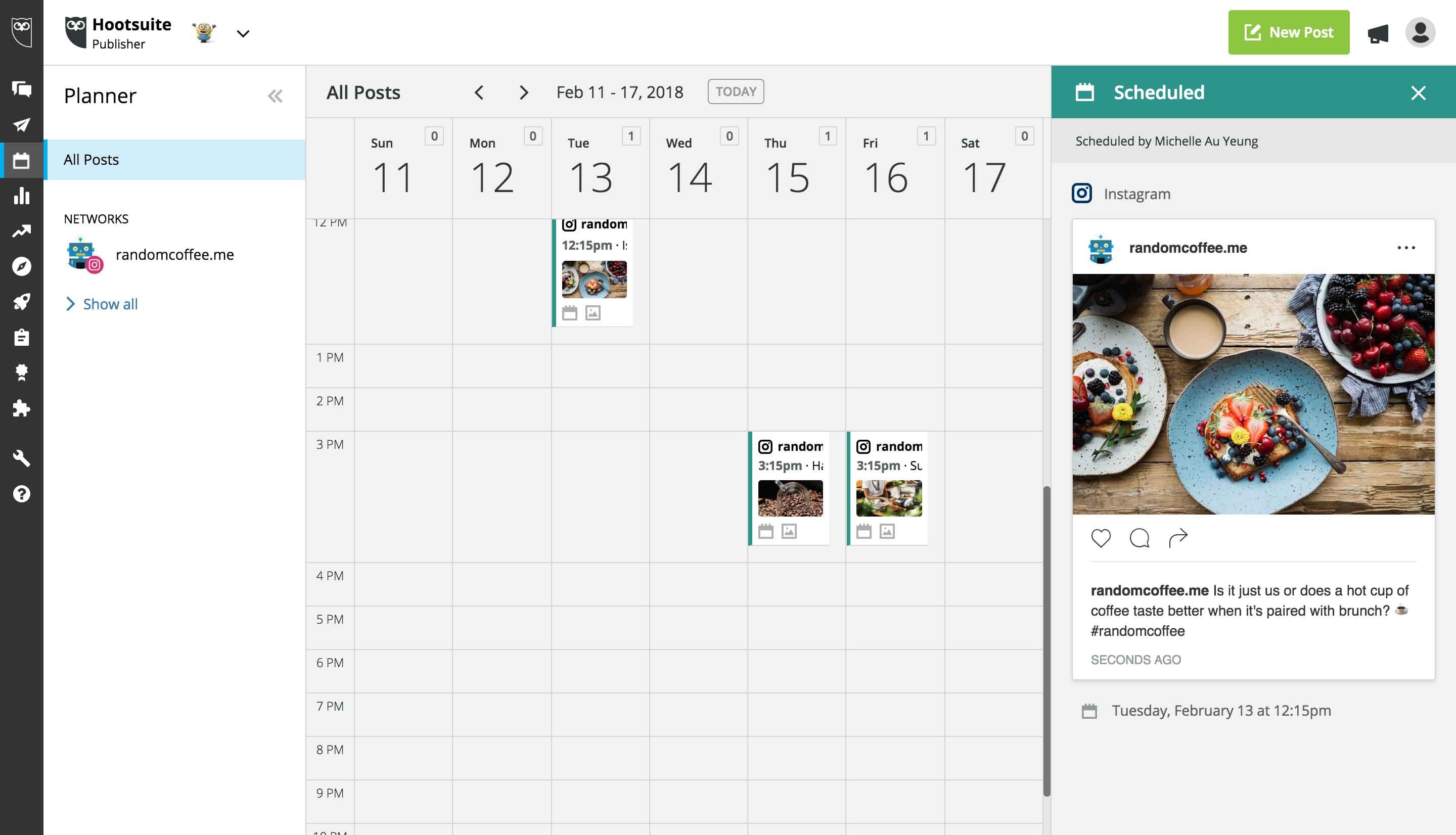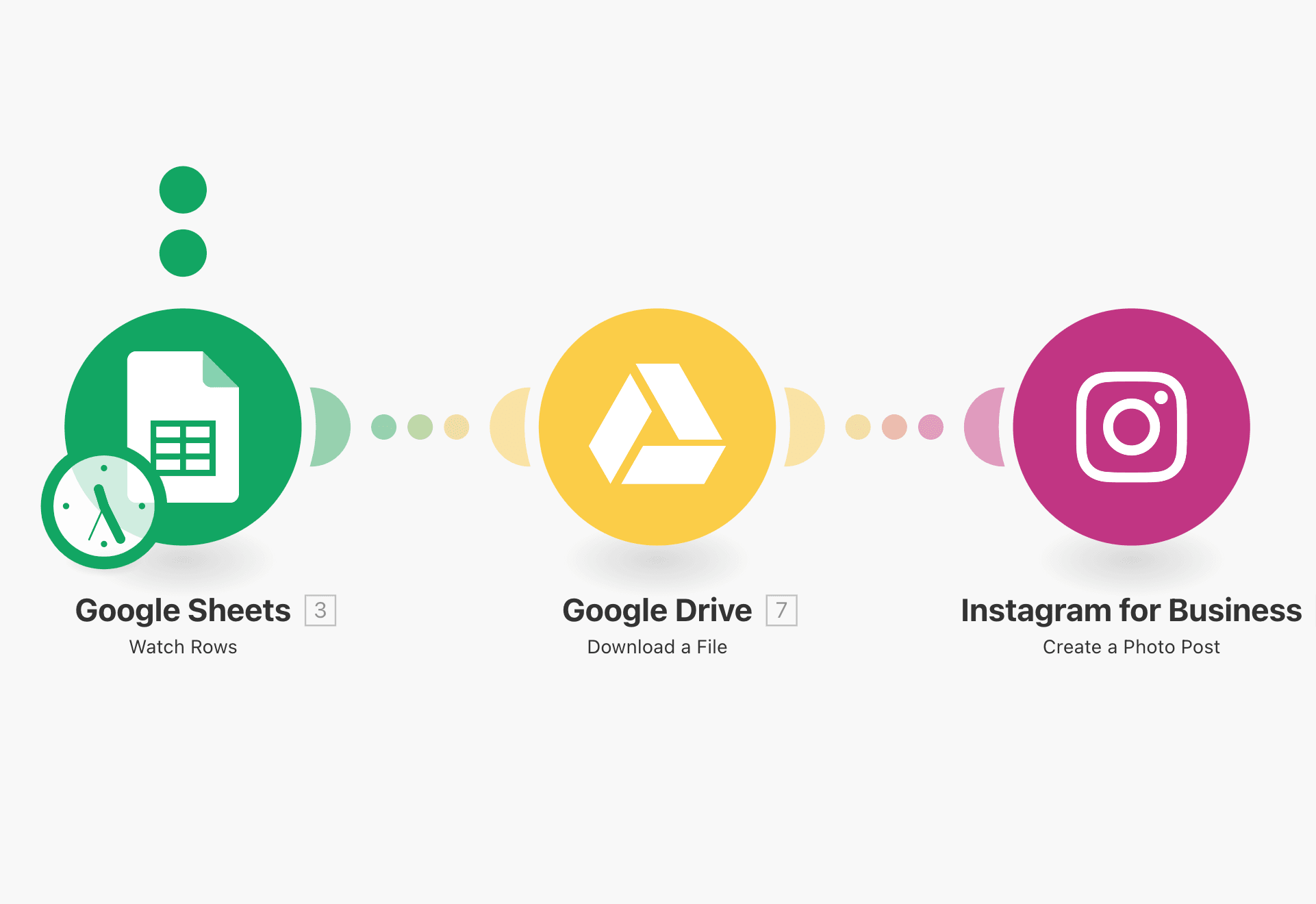May 12, 2021 | 8 minutes
Instagram for Business Automation: Tips and Best Practices
Learn how automation can help you tackle the typical challenges you face when using Instagram for Business.

Boasting a billion users, Instagram is unavoidable in today’s social media landscape.
Naturally, this massive user base has turned the platform into a magnet for ad dollars. To help businesses promote their products and services, the company introduced a set of tools, known as “Instagram for Business”.
Instagram for Business is generally used to place ads, promote publications, launch new products, and reach more people. In addition, it allows you to access key Instagram features, such as:
Instagram Shopping
Pinned comments
Call to action button
Instagram insights
In short, Instagram for Business is a great tool to improve your social media marketing efforts. However, running a successful Instagram account also involves a lot of tasks:
Coming up with a content strategy and calendar
Shooting pictures and videos for the posts
Editing and picking which visuals will be published
Crafting the content of the posts and selecting hashtags
Maintain consistency with the posting schedule
Monitoring current trends and competition
Managing comments, DMs, and other inquiries
Things can rapidly become overwhelming, especially if you don’t have a dedicated social media manager to handle it all.
Leveraging automation is one way companies can reduce some of this workload. By automating the repetitive, you can focus your efforts on the tasks that require a more creative, human input.
Benefits of automating Instagram for Business
Automation works best when applied to repetitive tasks that you need to run on a recurrent basis.
With this in mind, automation comes in handy to tackle the typical challenges businesses face when using Instagram for Business.
Let’s look at the benefits of doing so.
Facilitating social monitoring and listening
Social monitoring has become a vital part of social media. Whether it’s for content curation or monitoring brand mentions, it’s important to stay on top of what’s going on.
Unfortunately, following up on trends, content, and mentions takes time.
Automation can help you by keeping an eye on your audience and industry, providing you with the data you need to stay on top of everything.
Gathering insights in an instant
Instagram for Business can provide you with plenty of data to drive your strategy and understand your audience better. By diving into these insights, you’ll be able to gather a lot of information, including:
When is the best time to post
Which posts your audience enjoys most
What is your ideal posting frequency
What drives signups or engagement
This data will help improve your Instagram strategy, and automation is how you avoid spending extra resources in gathering and filtering it.
Simplifying ad campaigns
Instagram allows for a great variety of advertising options, such as:
Photo and video ads
Carousel ads
Stories ads
Explore ads
IGTV ads
Instagram Shopping ads
However, Instagram ads are also usually significantly more expensive%20on%20Instagram%2C%20Baumwald%20said.) than their counterparts. If you’re budget-conscious, ads will require specific attention.
Automation can run and measure your campaign’s effectiveness by removing some of the human bias that shows when money is involved.
By adopting a “facts only” approach, you can find more success in your ad optimization efforts.
Identifying high-value followers and partnership opportunities
Along with monitoring trends and competition, social media is a perfect medium to create collaborative efforts.
From influencers to brand partnerships, promoting your products on Instagram is a great way to expand your exposure and create social proof.
As a matter of fact, research has shown that 58% of Instagram users have become more interested in a brand or product after seeing it in Stories.
Creating branded content, collaborating with creators or regramming are ways to engage users in the content they already consume.
But where to begin? Unless you have time to spend your whole day on Instagram, automation can help by identifying these opportunities based on data.
Sorting through incoming requests and comments
Too many people sliding in your DMs? While it sounds like a nice problem for a business, it can rapidly become overwhelming.
Instagram for Business offers a convenient primary / general tab system that sorts through these messages to identify the best opportunities. Automation can take it further; an example of this is filtering messages by keywords.
Starting with Instagram for Business automation
Automating Instagram for Business can be done in different ways:
Native Instagram for Business features
Specialized tools
Automation platforms
Each has its pros and cons and should be used depending on goals and needs.
To show you how to automate Instagram for Business, we’ve selected three problems most users face:
Posting lots of content on a regular basis
Sharing content across multiple platforms
Gathering key data to help the strategic decision-making process
Let’s jump into it.
Create a content calendar to prepare posts in advance
One of the most challenging things about finding success on social media is to maintain consistency.
Brands post on average 29.7 times a month. A similar volume can be difficult to sustain in the long run, due to the variety of tasks involved:
Coming up with ideas
Creating high-quality pictures and videos
Crafting the copy of the post
Experimenting with different posting times
Thankfully there are automated solutions to help with this.
1. Native feature for posting: Facebook for Business
Facebook for Business is the native content scheduling tool to manage the Instagram for Business interface.
You can rely on it to schedule upcoming posts, and publish them at a predetermined date and time.
This is arguably the easiest way to schedule posts. The interface is straightforward, readily available, and gets the job done. It’s also free.
However, it may lack personalization depth if you’re trying to achieve maximum results.
Image Source: Facebook for Business
2. Specialized content scheduling tools: Buffer, Hootsuite
If you’re looking to go a bit deeper and get access to more features, content scheduling tools like Buffer or Hootsuite are right down your alley.
These enable you to schedule posts for publication and also come with extra features, including:
Image editing
Posts insights
Smart recommendations
Monitoring trends
Buffer and Hootsuite are recommended in the case you’re also publishing content on other platforms, or if you’re managing different brands and need a single dashboard.
On the other hand, you might find them a bit too pricey if you’re running a small operation.
Image Source: The Verge
3. Automation platform: Make
Automation platforms can be used to automate Instagram for Business.
With Make, you can connect Instagram for Business with other apps and create virtually any automated workflow you can think of.
This is best-fitted for:
Crafty users who want total control over their custom automated workflows
Budget-conscious teams that don’t want to overpay for features they won’t use
Make also offers templates to automate in minutes, saving you valuable implementation resources from the get-go.
Use this template to create a post on Instagram from a file from Google Drive every time a new row is added to a new Google Sheets spreadsheet.
Share your content across platforms
Instagram is über-popular, but your audience is most likely active on other social media platforms as well.
As a matter of fact, only 1% of Instagram users use no other social platforms.
To cover their bases, most businesses do a very simple thing: Sharing content to different platforms.
However, repurposing content takes time and energy. You have to adapt it to different formats, create variations of it, and post it.
This can be done with two main objectives in mind:
Promoting your Instagram posts elsewhere to boost their reach
Repurposing Instagram posts across social media platforms
Let’s look at an example for each.
1. Promoting your Instagram posts elsewhere to boost their reach
One of the main difficulties in managing social media channels is to gain traction and bring users to your content.
While paying for ads is always a possibility, let’s consider how automation can help without breaking the bank.
One of the ways you can promote your content is by sharing it in relevant communities across the internet. Depending on your industry, this could mean:
Facebook groups
Specialized subreddits
Online forums and communities
Q&A platforms like Quora
This can be automated by putting together a list of relevant online spaces and automatically publishing new content there.
You should of course be cautious to not appear spammy, but it can serve as a great base for an automated Instagram promotion machine.
Use this template to automatically post new Instagram photos you upload to a selected Facebook group.
2. Repurposing Instagram posts across social media platforms
The second objective is to cross-post content directly on other platforms.
Since you’re putting together content for Instagram, it would be a shame not to share it with your Facebook and Twitter followers for example.
This is a textbook automation use case.
The posts are already crafted and only need to be copied and pasted to other platforms, which automation can handle for you. As with content scheduling, this can be handled in three different ways:
Facebook for Business: If you’re only cross-posting on Facebook and Instagram
Scheduling tools: If you want to manage your different platforms in one place
Make: If you want to automatically cross-post on any platform at a lesser cost
Use this template to automatically post on Twitter new photos you upload to Instagram.
Gather insights and improve your social media strategy
If running your social media feels like a guessing game, you’re doing it wrong.
Your strategy should be driven by data.
In addition, you have to consider the success of your previous efforts to make educated decisions going forward.
Thankfully, Instagram for Business features extensive insights about your post and campaign performances.
Image Source: Search Engine Journal
These allow you to learn more about the following:
Your audience
What engagement looks like (likes, comments, follows)
The best time to post
While this is valuable information, doesn’t it feel like it takes too much to check on it?
Most importantly: Aren’t you tired of having to do it?
Make can help you by automatically forwarding that information to wherever you want.
Some examples of projects you could implement include:
Receiving a summary of your weekly performance by email every Friday
Building a custom social media dashboard to display your progress
Putting together a graph correlating the day and time of posting and engagement
Identifying new high-profile followers or engagement for a possible outreach
Forwarding Instagram for Business insights to Google Sheets is a great, easy start.
Use this template to automatically save media insight from Instagram to Google Sheets.
Conclusion
While not everything should be automated, every business can benefit from Instagram automation.
For example, an artisanal furniture store could set up a filter in their DMs and automatically trigger the sending of a digital form when the word “budget” appears in a message.
Another example could be a boxing gym configuring an alert every time one of its competitive boxers is mentioned on Instagram.
The possibilities are almost endless.
The key is to focus on value-generating automation that saves you time. In turn, you’ll be able to focus on:
Fostering a community with your audience
Engaging users and staying responsive
Coming up with great content
Interpreting collected data to improve your strategy
Instagram is a great platform to connect with your audience, improve your messaging and generate business.
Automate Instagram, and concentrate on providing the human touch - you won’t be disappointed!








